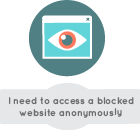I need to check out a website that is blocked or whose content is not legal in my country. Is there a way to do this without drawing attention to myself?

You live in a country that censors certain websites and online services, preventing you from reading them when you type their URL into your browser. In other cases, websites are accessible but their content is illegal where you live. You might face fines or imprisonment if you were found to have accessed these websites, or downloaded particular content. Or you simply want to visit a website without leaving a trace or allowing others “watching” the traffic to know.
What you should do
There are three options to access content that is censored, unavailable in your location or simply taboo. They differ in terms of the security and anonymity they provide to you, but also in terms of ease of use.
- The first is to use a virtual private network (VPN). VPNs enable a properly configured device to send and receive all data through another computer network. For example, if you are using a VPN to access https://apc.org, your computer first connects to the VPN, which then connects to https://apc.org on your behalf and sends back the result. When you connect to the internet through a VPN all your traffic and activities must be encrypted, so ensure that your VPN provider is implementing security properly. This encrypted “tunnel” protects you from surveillance and allows you to bypass censorship.
- With an onion routing network such as Tor, your traffic is bounced through at least three other anonymising nodes or points to your requested destination and back, providing multiple layers of anonymity that effectively obfuscates your identity. The Tor Browser is an easy application to download and install and requires little to no configuration. Tor, however, is not secure. Unless you use HTTPS – and you should always use HTTPS – and email encryption, any node or point in the Tor network can see, store and disclose the full details of your communication. Tor is also notoriously slow.
- A web proxy is perhaps the easiest tool for quick access to a blocked website. Similar to a VPN, you simply navigate to a proxy website and type in the URL that you wish to access. The proxy (an intermediary server) fetches the site for you and returns it, often with ads and other unwanted code embedded. It is not recommended to access websites regularly using a web proxy. And never use your regular browser to access a site with a proxy since your web browser contains data about you, called a fingerprint, such as your history and session cookies.
Keep in mind
- Although your traffic is secured between you and the VPN, the VPN provider must be trusted because they can see, store and disclose the details of your traffic.
- While Tor provides anonymity, it does not secure the content of your communications from eventual eavesdroppers.
- Do not trust a VPN or the Tor network with your communications. Always use HTTPS when browsing and OpenPGP encryption when sending emails while connected to a VPN or Tor. If you can’t use HTTPS to visit some sensitive websites or don’t have OpenPGP encryption set up for your email client, then you shouldn’t use Tor or an untrusted VPN, period.
- Whatever precautions you take to anonymously browse blocked or illegal content, your browser is configured by default to remember your browsing history. So in the case that your computer is seized or hacked, the intruder can easily check which websites you’ve visited. If this is a concern for you, configure your browser in such way that it doesn’t record browsing history.
Where to find more help
- Learn about how to bypass censorship
- Learn about extending your Firefox browser security
- Learn about Tor
- See an interactive illustration of how HTTPS and Tor make you both secure and anonymous.
- Learn about Riseup VPN and about TunnelBear VPN
- Assess whether using a VPN will give you the protection you need.
- Disable browsing history in Mozilla Firefox
Temporarily disable browsing history in Chrome .